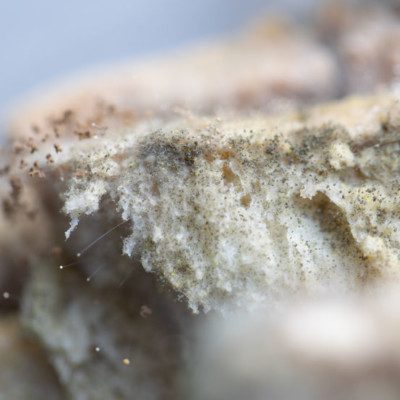How does it work?
Rope in bread is primarily caused by B. subtilis and B. mesentericus. However, B. licheniformis, B. megaterium and B. cereus are also capable of causing rope. B. subtilis is a gram-positive, aerobic, spore-forming soil bacterium found in soil, dust, water and even air.3
Bread contaminated with rope spoilage initially develops an unpleasant fruity odor similar to a strong scent of rotting pineapple or melon in a period of 12–24 hours. As time passes, this is followed by a discolored, sticky or soft bread crumb. When cut surfaces of the loaf are slowly pulled apart, thin strands or ‘ropes’ can be seen stretching from one surface to the other. Bread adulterated by rope spoilage is rendered inedible and ultimately thrown away.4
The time taken for rope spoilage to become obvious depends on the level of contamination, and the conditions of storage such as temperature and relative humidity. The heavier the contamination and the warmer the conditions, the faster rope development will be.4
Causes
Shelf-life factors such as moisture content (35–42%) and water activity of crumb (0.90–0.95) of most yeast-leavened bakery products make them well suited for the development and growth of rope-causing bacteria and hence susceptible to rope spoilage.
The bacteria B. Subtilis and B. mesentericus both occur naturally in the soil and can be easily carried along with agriculture commodities to the next stages of the food supply chain, thus creating cross-contamination and spoilage issues at the manufacturing level. Rope spoilage should not be consumed, so discard any food you suspect is affected.
Sources of rope spores
Flour
Given its origin, field post-harvest, nature of milling process and lack of kill steps, flour has the potential to introduce greater number of rope spores per gram than any other ingredient to the baking process.4
Whole wheat flour, a material that retains the outer layers of pericarp and is exposed to ambient and soil conditions, can introduce considerably higher microbial load into doughs. As a consequence, bakery products such as artisan, wheat and whole wheat bread carry a higher risk of quality issues related to rope.4
Other ingredients
Other sources of rope spoilage include shortenings, liquid whole eggs, sucrose, nonfat dry milk, liquid milk, liquid sweeteners (HFCS, 42 DE corn syrup, honey and molasses) and water. Periodic lab testing of such ingredients can help determine the source of biological contamination.1
Shift towards natural ingredients
Conversion of some bakeries from using the antimicrobial calcium propionate to vinegar has also been suspected of enhancing rope spoilage due to the inefficiency of vinegar in dropping the pH.
Approaches to rope control
Implementation and enforcement of good manufacturing practices, pre-requisite programs, food safety systems are necessary for reducing the proliferation of rope-causing bacteria. Following are examples of some guidelines which may help in reducing the incidence of rope spoilage.
- Formulation: Use effective microbial inhibitors to lower crumb pH to 5.4 or less.
- Long fermentation times help in lowering dough pH below 4.6 (natural acidification of dough and bread).
- Follow proper sanitation practices and programs including hygienic design, cleaning, supplier verification, ingredient microbiological analysis, etc.
- Prevention of cross-contamination: do not allow freshly baked bread to come into contact with ingredients and/or with stale bread).
- Careful use of protein-rich ingredients that function as pH buffers (eggs, vital wheat gluten, milk solids, flour). These can increase the pH, limiting effectiveness of preservatives.
- Use heat treated flour: treatment of grain by infrared irradiation or other strategies can reduce microbial load.
- Use effective chemical acidulants as preservatives: propionic acid and monocalcium phosphate at levels of 0.1–0.5%. Using higher amounts of these preservatives may require increasing the amount of yeast in the dough.
- Use proper HVAC systems to reduce the risk of air-borne contamination from outside the bakery.
References
- Charles Hoffman, Robert Schweitzer, and Gaston Dalby. “Control of Rope in Bread”. Industrial and Engineering Chemistry. 1937;29:464–466.
- E. J. Cohn, S. B. Wolbach, L. J. Henderson, P. H. Cathcart. “On the Control of Rope in Bread”. The Journal of General Physiology. 1918;2:221–230.
- Tam, Nguyen K. M., Nguyen Q. Uyen, Huynh A. Hong, Le H. Duc, Tran T. Hoa, Claudia R. Serra, Adriano O. Henriques, and Simon M. Cutting. “The Intestinal Life Cycle of Bacillus Subtilis and Close Relatives.”Journal of Bacteriology. American Society for Microbiology, Apr. 2006.
- Cauvain, S.P. “Bread and Other Fermented Products.” Baking Problems Solved, 2nd edition, Woodhead Publishing, Elsevier Ltd., 2017.

